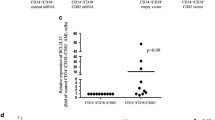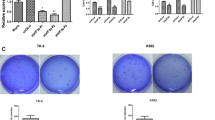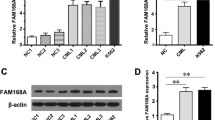Abstract
Objective
Despite considerable improvement in therapeutic approaches to chronic myeloid leukemia (CML) treatment, this malignancy is considered incurable due to resistance. However, investigating the molecular mechanism of CML may give rise to the development of extremely efficient targeted therapies that improve the prognosis of patients. Basic leucine zipper transcription factor ATF-like3 (BATF3), as transcription factor, is considered a key regulator of cellular activities and its function has been evaluated in tumor development and growth in several cancer types. This study aimed to evaluate the potential of the cellular impact of siRNA-mediated downregulation of BATF3 on CML cancer cells through cell proliferation, induction of apoptosis, and cell cycle distribution.
Materials and methods
The transfection of BATF3 siRNA to K562 CML cells was performed by electroporation device. To measure cellular viability and apoptosis, MTT assay and Annexin V/PI staining were carried out, respectively. Also, cell cycle assay and flow cytometry instrument were applied to assess cell cycle distribution of K562 cells. For more validation, mRNA expression of correlated genes was relatively evaluated by quantitative real-time polymerase chain reaction (qRT-PCR).
Results
The data indicated that siRNA-mediated BATF3 inactivating severely promoted the cell apoptosis. Also, the targeted therapy led to high expression of Caspase-3 gene and Bax/Bcl-2 ratio. Silenced BATF3 also induced cell cycle arrest in phase sub-G1 compared to control. Finally, a noticeable decrement was obtained in c-Myc gene expression through suppression of BATF3 in CML cells.
Conclusion
The findings of this research illustrated the suppression of BATF3 as an effective targeted therapy strategy for CML.






Similar content being viewed by others
Data availability
All data generated or analyzed during this study are avaidable upon request.
References
Chereda B, Melo JV (2015) Natural course and biology of CML. Ann Hematol 94(2):107–121
Cortes JE, Talpaz M, Kantarjian H (1996) Chronic myelogenous leukemia: a review. Am J Med 100(5):555–570
Jabbour E, Kantarjian H (2018) Chronic myeloid leukemia: 2018 update on diagnosis, therapy and monitoring. Am J Hematol 93(3):442–459
Aladağ E, Haznedaroğlu İC (2019) Current perspectives for the treatment of chronic myeloid leukemia. Turk J Med Sci 49(1):1–10
Chavez-Gonzalez A, Bakhshinejad B, Pakravan K, Guzman ML, Babashah S (2017) Novel strategies for targeting leukemia stem cells: sounding the death knell for blood cancer. Cell Oncol 40(1):1–20
Jabbour E, Kantarjian H (2020) Chronic myeloid leukemia: 2020 update on diagnosis, therapy and monitoring. Am J Hematol 95(6):691–709
Jabbour E, Parikh SA, Kantarjian H, Cortes J (2011) Chronic myeloid leukemia: mechanisms of resistance and treatment. Hematol Oncol Clin North Am 25(5):981
Hashimoto I, Oshima T (2022) Claudins and gastric cancer: an overview. Cancers 14(2):290
Wagner EF, Eferl R (2005) Fos/AP-1 proteins in bone and the immune system. Immunol Rev 208(1):126–140
Eferl R, Wagner EF (2003) AP-1: a double-edged sword in tumorigenesis. Nat Rev Cancer 3(11):859–868
Echlin DR, Tae H-J, Mitin N, Taparowsky EJ (2000) B-ATF functions as a negative regulator of AP-1 mediated transcription and blocks cellular transformation by Ras and Fos. Oncogene 19(14):1752–1763
Murphy TL, Tussiwand R, Murphy KM (2013) Specificity through cooperation: BATF–IRF interactions control immune-regulatory networks. Nat Rev Immunol 13(7):499–509
Benckendorff J, Kuchar J, Leithäuser F, Zahn M, Möller P (2021) Usefulness of BATF3 immunohistochemistry in diagnosing classical Hodgkin Lymphoma. Diagnostics 11(6):1123
Mojtahedi H, Yazdanpanah N, Rezaei N (2021) Chronic myeloid leukemia stem cells: targeting therapeutic implications. Stem Cell Res Ther 12(1):603
Singh VK, Coumar MS (2019) Chronic myeloid leukemia: existing therapeutic options and strategies to Overcome Drug Resistance. Mini Rev Med Chem 19(4):333–345
Meenakshi Sundaram DN, Jiang X, Brandwein JM, Valencia-Serna J, Remant KC, Uludağ H (2019) Current outlook on drug resistance in chronic myeloid leukemia (CML) and potential therapeutic options. Drug Discovery Today 24(7):1355–1369
Dessie G, Derbew Molla M, Shibabaw T, Ayelign B (2020) Role of stem-cell transplantation in leukemia treatment. Stem Cell Cloning 13:67–77
Hildner K, Edelson BT, Purtha WE, Diamond M, Matsushita H, Kohyama M et al (2008) Batf3 deficiency reveals a critical role for CD8alpha + dendritic cells in cytotoxic T cell immunity. Science 322(5904):1097–1100
Tussiwand R, Lee WL, Murphy TL, Mashayekhi M, Kc W, Albring JC et al (2012) Compensatory dendritic cell development mediated by BATF-IRF interactions. Nature 490(7421):502–507
Cao L, Liu Y, Wang D, Huang L, Li F, Liu J et al (2018) MiR-760 suppresses human Colorectal cancer growth by targeting BATF3/AP-1/cyclinD1 signaling. J Exp Clin Cancer Res 37(1):83
Li P, Weng Z, Li P, Hu F, Zhang Y, Guo Z et al (2021) BATF3 promotes malignant phenotype of colorectal cancer through the S1PR1/p-STAT3/miR-155-3p/WDR82 axis. Cancer Gene Ther 28(5):400–412
Vrzalikova K, Ibrahim M, Vockerodt M, Perry T, Margielewska S, Lupino L et al (2018) S1PR1 drives a feedforward signalling loop to regulate BATF3 and the transcriptional programme of Hodgkin lymphoma cells. Leukemia 32(1):214–223
Gonzalez MS, De Brasi CD, Bianchini M, Gargallo P, Moiraghi B, Bengió R et al (2010) BAX/BCL-XL gene expression ratio inversely correlates with Disease progression in chronic Myeloid Leukemia. Blood Cells Mol Dis 45(3):192–196
Carter BZ, Mak PY, Mu H, Zhou H, Mak DH, Schober W et al (2016) Combined targeting of BCL-2 and BCR-ABL tyrosine kinase eradicates chronic myeloid leukemia stem cells. Sci Transl Med 8(355):355ra117-355ra117
Brentnall M, Rodriguez-Menocal L, De Guevara RL, Cepero E, Boise LH (2013) Caspase-9, caspase-3 and caspase-7 have distinct roles during intrinsic apoptosis. BMC Cell Biol 14:32
Parrish AB, Freel CD, Kornbluth S (2013) Cellular mechanisms controlling caspase activation and function. Cold Spring Harb Perspect Biol 5(6):a008672
Di Bacco AM, Cotter TG (2002) p53 expression in K562 cells is associated with caspase-mediated cleavage of c-ABL and BCR-ABL protein kinases. Br J Haematol 117(3):588–597
Lu Y, Chen G-Q (2011) Effector caspases and Leukemia. Int J Cell Biol 2011:738301
Sodaro G, Cesaro E, Montano G, Blasio G, Fiorentino F, Romano S et al (2018) Role of ZNF224 in c-Myc repression and imatinib responsiveness in chronic Myeloid Leukemia. Oncotarget 9(3):3417
Sharma N, Magistroni V, Piazza R, Citterio S, Mezzatesta C, Khandelwal P et al (2015) BCR/ABL1 and BCR are under the transcriptional control of the MYC oncogene. Mol Cancer 14(1):1–11
Zhu J, Sunohara M, Benyoucef A, Brand M (2018) Targeting the process of C-MYC stabilization in chronic myelogenous Leukemia. Exp Hematol 64:S114
Lollies A, Hartmann S, Schneider M, Bracht T, Weiß AL, Arnolds J et al (2018) An oncogenic axis of STAT-mediated BATF3 upregulation causing MYC activity in classical Hodgkin Lymphoma and anaplastic large cell Lymphoma. Leukemia 32(1):92–101
Gavrilov K, Saltzman WM (2012) Therapeutic siRNA: principles, challenges, and strategies. Yale J Biol Med 85(2):187
Petri S, Meister G (2013) siRNA design principles and off-target effects. Target Identif Valid Drug Discov. https://doi.org/10.1007/978-1-62703-311-4_4
Meng Z, Lu M (2017) RNA interference-induced innate immunity, off-target effect, or immune adjuvant? Front Immunol 8:331
Acknowledgements
The authors are thankful for supports from the Immunology Research Center, Tabriz University of Medical Sciences, Tabriz, Iran.
Funding
We didn’t receive grant for this research.
Author information
Authors and Affiliations
Contributions
RD: Conceptualization, investigation, formal analysis, Writing—Original Draft. VKS: Validation, formal analysis, data curation. SS: Validation, formal analysis, data curation. MA: Validation, formal analysis, data curation. SMBT: Writing—review & editing, data curation. DS: Writing—review & editing, data curation. ORF: Validation. EM: Supervision, project administration. BB : Supervision, project administration.
Corresponding authors
Ethics declarations
Conflict of interest
The authors declare that they have no known competing financial interests or personal relationships that could have appeared to influence the work reported in this paper.
Ethical statement
All experiments and procedures were conducted in compliance with the ethical principles of Shiraz University of Medical Science, Shiraz, Iran and approved by the regional ethical committee for medical research.
Additional information
Publisher’s Note
Springer Nature remains neutral with regard to jurisdictional claims in published maps and institutional affiliations.
Rights and permissions
Springer Nature or its licensor (e.g. a society or other partner) holds exclusive rights to this article under a publishing agreement with the author(s) or other rightsholder(s); author self-archiving of the accepted manuscript version of this article is solely governed by the terms of such publishing agreement and applicable law.
About this article
Cite this article
Dabbaghipour, R., Khaze Shahgoli, V., Safaei, S. et al. siRNA-mediated downregulation of BATF3 diminished proliferation and induced apoptosis through downregulating c-Myc expression in chronic myelogenous leukemia cells. Mol Biol Rep 51, 100 (2024). https://doi.org/10.1007/s11033-023-09059-z
Received:
Accepted:
Published:
DOI: https://doi.org/10.1007/s11033-023-09059-z




